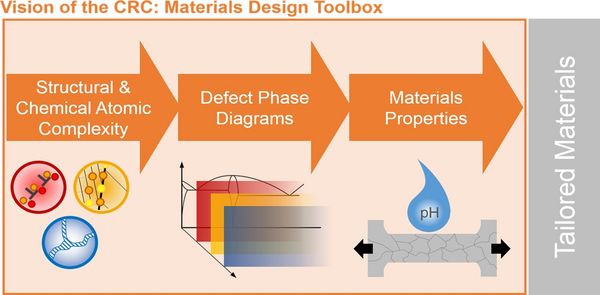Vision of SFB1394
Structural and chemical atomic complexity – from defect phase diagrams to material properties
- Create: quantitative description of structure + chemistry + thermodynamics of defects
- Establish: direct links between mechanics and corrosion in materials design
- Pioneer: paradigm change in the description of metallic materials

The design of new metallic materials is essential in fulfilling the promise of emerging and improving key technologies from efficient energy conversion over lightweight transport to safe medical devices. Over the last decades, two approaches in materials physics have proven immensely successful in the design of new metallic materials: Firstly, thermodynamic descriptions of crystalline phases have enabled materials scientists and engineers to tailor and process alloys to obtain a desired internal structure at the microscale. Secondly, better understanding and manipulation of the crystal defects, which govern the material’s strength, formability and corrosion resistance, has led to the development of new alloying and processing concepts that provide some of the most advanced high-performance alloys in operation today. However, to date, these two concepts remain essentially decoupled.
The vision of this SFBis to bridge the gap between these existing and powerful approaches by bringing them together in one new conceptual framework, which will consider defects and their thermodynamic stability in a holistic manner. Consequently, a new material design concept originating from the atomic scale will be accessible to materials physicists and engineers which jointly considers the local crystalline structure of defects (structural complexity), the atomic distribution of each element among the different types of phases and defects (chemical complexity) and the stability of defects under the given conditions, such as bulk composition, temperature and applied stress or electrode potential. These will be linked by defect phase diagrams, which will describe the transition between and the coexistence of defect phases.
This structural and chemical complexity at the atomic scale naturally exists in all materials. The SFB will provide new quantitative descriptors of the local structure and chemistry of defects which govern materials' bulk properties. We believe this will cause a paradigm change in the physical description of metallic materials and will provide a powerful toolbox for future design of engineering materials with tailored properties regarding both, mechanical and corrosion performance.


